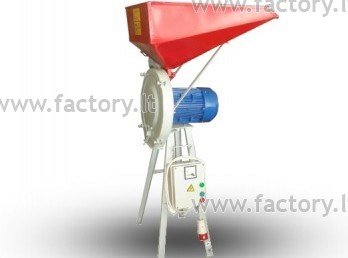Grain mill is intended to mill grains for feeding animals in an individual farms.
Grain mills are an essential element of any livestock feeding operation, whether you are feeding cattle, horses, sheep, goats, poultry, or pigs. Getting the maximum animal nutrition out of grain means cracking the hull of oats, barley, corn, and, even legumes like peas and beans.
Grinded grains better contact with the digestive juice in stomach, so nourishment is better absorbed by animal.
Grain mill main components:
1. Bunker
2. Body
3. Stand
4. Rotor
5. Sieve
6. Fastener
7. Engine box
8. Electric motor
9. Cover
Operating principle
The bunkered grains falls through the latch into the crusher, where the rotating hammers crush its.
Latch is opened only with the neglected engine.
Finished product crumbles fall into the bag fixed on the holders.
The coarseness of finished product depends on sieve.
Technical data:
| Model | GMM-1A | |
| Electromotor power, kW | 3,0 | 5,5 |
| Output, kg/h | from 165 to 200 | from 280 to 350 |
| Capacity, l | ~20 | |
| Rotor frequency, min-1 | 3000 | |
| Sieve holes size, mm | from 3 to 4 | |
| Working time, min | till 60 | |
| Size (length/width/height), m | till 0,7/0,6/1,5 | |
| Weight, kg | 79 | 100 |
Advantages:
- You can change sieves to change the fraction of grinded material
- Milled grains are better absorbed by the animals
- Good choice for small farms
Tips:
Grains must be dry and clean
It is recommended to put grain mill on a rubber mat. This helps to reduce vibration and noise.
The operator must ensure that grain meal can go out free from the grinder into the bag.
Do not overfill the bag.
If there is no space for flour to drop-out, a gap between the working chamber and the sieve will be plugged.
Includes:
- Spare set of hammers
- The second sieve
- Pick
Contact us if you want to buy right size sieve or grain mill.





